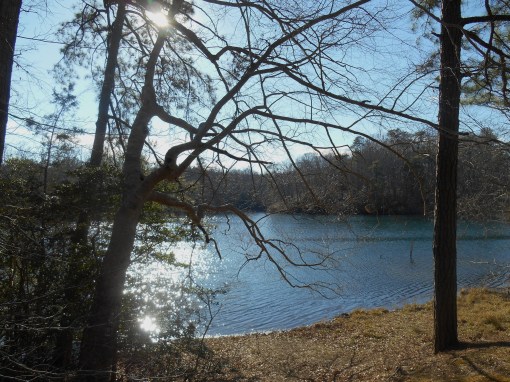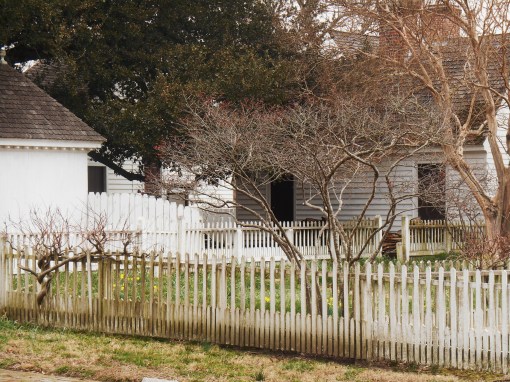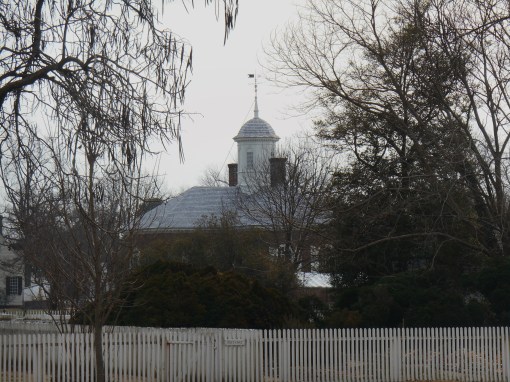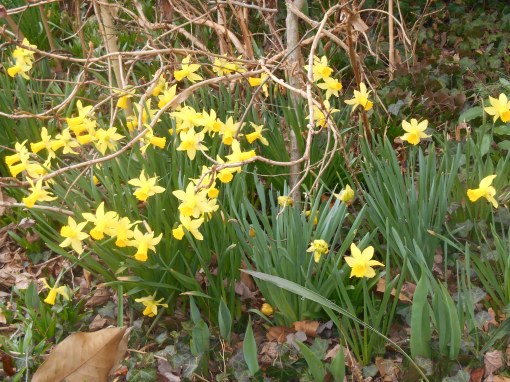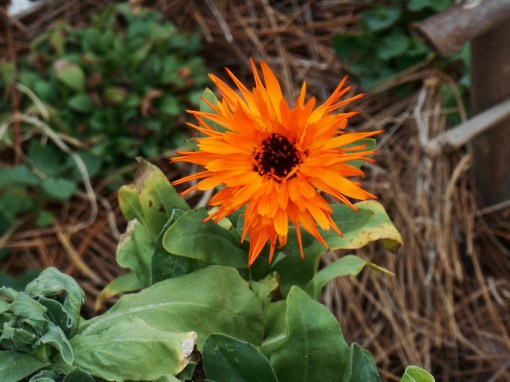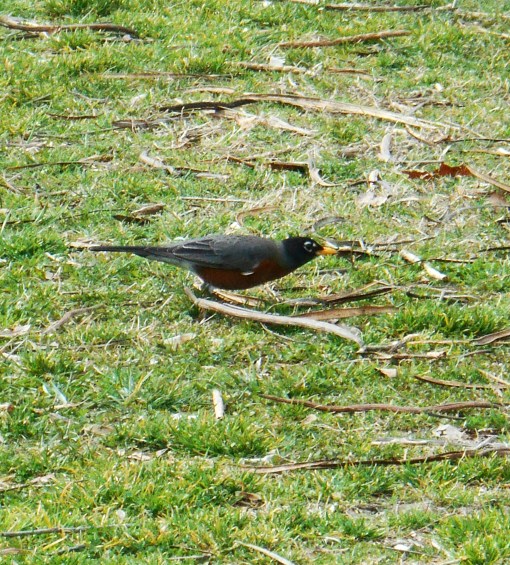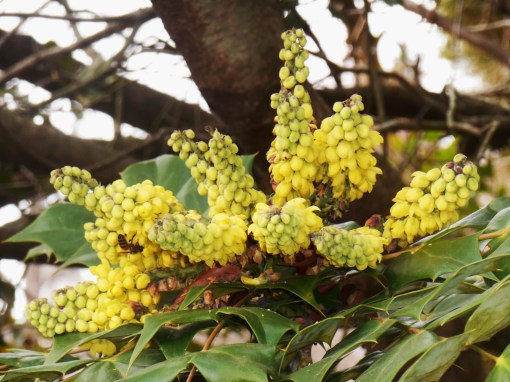
Daffodils blooming in our garden today.
I felt the itching last night right as we began dinner.
My family had gathered at my parents’ home yesterday, and several of us spent a few hours in the afternoon doing some light yard work to help them out. We’d picked up sticks and trimmed some bushes; nothing too intense.
And since there was snow and ice earlier in the week, none of us gave a thought to what insects might be prowling about. Sure, there were some bumblies on the Mahonia blossoms, but none of us worried about ticks.

Mahonia blooming at Colonial Williamsburg last week.
But then at dinner, I felt the tell-tale itching, and reaching up to scratch the itch, my fingertips touched tick.
Once you’ve had a tick, their feel is unmistakeable. You know immediately that one is embedded in your flesh, and must be removed, NOW!
At first I tried to lightly brush it away. But no, a tick is tenacious. Thank goodness my sister sprang into action. A dedicated animal lover, she has removed many ticks from her companions and was willing to do the same for me.

Since I’m positive you don’t want to see my tick bite, or the tick, I’ll just show you some garden photos today. This is our lilac, “Josee” beginning to open.
You can’t just pull a tick out. Often, the tick will just pull apart, and the head will be left embedded in your skin.
You need to get it to back out and begin to let loose before you try to remove it.

Vinca is lovely in early spring when it blooms with either periwinkle blue, or white, blossoms. The rest of the year Vinca is a tough, evergreen vining ground cover.
We first covered this one in petroleum jelly. Ticks, like all insects, breathe through the hard shell of their exoskeleton. Tiny holes in their hard covering allow for respiration. Cover these holes, and they begin to suffocate.
Whatever anyone recommends that you do to a tick before pulling it out is designed to distract them, put them under stress, and make them let loose the tight hold they have on the flesh from which they are feeding.
After a minute or so, she began to work on the tick with a pair of tweezers. What a hold it had! It had burrowed into the back of my neck right at the hairline. It took several tries, but she eventually yanked it out. We swabbed the bite with alcohol and applied a topical antibiotic.

Miniature daffodils have emerged around a Rosemary, badly damaged this winter by cold. We hope the Rosemary shrubs in our garden have survived the winter.
Now ticks are virulent creatures. As they suck, they also release chemicals into your skin.
Sometimes ticks also carry disease, such as Lyme’s disease, which they transmit through their bite. The area around the bite was already red and inflamed before my sister removed the tick, and is more so today.
The intense itching had me up in the night reapplying a topical antibiotic, and had us heading out to the see a doctor this morning, before I even brewed a pot of coffee.

More miniature daffodils in the front border. These were purchased from Brent and Becky Heath in Gloucester, VA.
The doctor who took a look at the tick bite praised my sister highly for her quick action and the thoroughness with which she managed to remove the tick.
Nothing was left behind in the wound, which is good. But, we still decided to begin a course of Doxycycline today to prevent any tick borne illness from gaining a foothold.
Doxycycline is sometimes prescribed to those heading into regions known for Malaria, to prevent contracting the disease from a mosquito bite. I expect it to prevent any infection from this little bite.

These daffodils in shades of pink, purchased from the Heaths, have begun to grow on me. Do you like them?
The tick we removed yesterday was a light brown color, and it was fairly large. I’m guessing it might have been a brown dog tick.
There are at least seven different ticks active in the United States, and each carries slightly different diseases.
A friend removes ticks from her pets and children using clear tape, and keeps the tick, sandwiched in the tape, in case she needs it later for identification or to show her physician.
That is a great idea, and I didn’t even think to suggest it last night. We tweezed and flushed, while the rest of the family struggled to keep on with their dinner!

Now that we know ticks are moving this spring, there are some precautions to take:
1. From now on, I’ll begin wearing insect repellent when working outside. Since we live in a forest, this is something that we routinely do once the weather warms. My parents’ suburban yard has not been known for ticks in the past, and none of us even considered insect repellant yesterday.
2. It is wise to not only wear long sleeves, long pants, and socks when working out of doors, but also hat and gloves. I didn’t have a hat yesterday, and yet was trimming tall shrubs. This little guy might have fallen into my hair while I was trimming the shrubs.
3. At home, we normally head straight from the garden to the shower. A good shower allows one to locate and remove ticks quickly. Sometimes we find them still crawling, before they have had a chance to dig in.
We also leave our clothing in the garage, so any ticks on our clothing can’t make it into the house.

Violas. See the garlic I’ve placed in each pot of Violas to discourage the deer?
As Lyme disease becomes more prevalent, we all need to remain vigilant to protect ourselves from tick bites. Lyme is debilitating for many who contract it, and affects many different systems of the body.
Lyme disease was unknown before the early 1970s. It first showed up around Lyme, Connecticut, in children and adults who began showing unusual, arthritis like symptoms.
The connection between Lyme disease and deer ticks was finally established around 1981 by the National Institute of Allergy and Infectious Disease in Montana.

A new variety of bulb has begun to emerge. We purchased these from Roxy Patton at Homestead Garden Center this fall, but I don’t recall the variety.
Even today, many physicians don’t recognize Lyme disease, especially symptom clusters which appear months or even years after the initial tick bite and rash. We are becoming familiar with the red, bull’s eye shaped rash which appears within a few days of the bite.
Once that rash goes away, Lyme Disease often remains in the body, to reappear months or years later with more serious symptoms. Many who have Lyme disease don’t even remember the initial tick bite.
Lyme, a bacterial infection carried in the blood, can be treated with antibiotics, and there is promising research into the effectiveness of colloidal silver for treating particularly difficult cases.

This gorgeous little daffodil was planted by a previous gardener on this property. I sometimes dig and divide these in late spring. They are so unusual!
Because Lyme disease only appeared in North America roughly 40 years ago, and because it first appeared in only one coastal community, and has spread across the country from there; there are many interesting theories as to its origin.
Interestingly, the US government’s Plum Island Biological Research Facility, in Long Island Sound, is only a few miles offshore from Lyme, Connecticut, where the disease originated in the 1970s.

We planted these daffodils in the fern garden three years ago. They have divided into nice clumps.
The Biological Research Facility was established in the early 1950’s, to house a research program under the direction of ex-Nazi scientist Erich Traub. Traub immigrated to the United States in 1949. He continued his research into diseases, under Project Paperclip, for the United States Government, at Plum Island, NY.
His earlier research into germ warfare had been carried out on Riems’s Island in the Baltic Sea, under the direction of Heinrich Himmler.
Traub had previously studied at the Rockefeller Institute for Medical Research in Princeton, New Jersey during the 1930s, performing research on viruses and vaccines. He and his wife lived only a few miles from Plum Island at that time.

A wider view of the daffies in the fern garden.
This Plum Island facility has carried out various research projects over the years, all involving animals and disease. Its location in Long Island Sound is intended to isolate the diseases studied, and the animal carriers, from the rest of the country.
Tick borne diseases are believed to have left the island on birds. Birds can easily fly back and cross Long Island Sound, carrying infected ticks. Deer also swim between the mainland and Plum Island, and could have carried ticks from the research facility to Connecticut.

The same pathogen, mycoplasma fermentens, is found in individuals infected with Lyme disease, Gulf War Syndrome, Chronic Fatigue Syndrome, and Fybromyalgia. All of these recent, baffling disease conditions tend to affect the central nervous system. All cause intense fatigue, and affect various other organs in the body.
Infected ticks multiply in warm weather and travel from yard to yard, area to area, state to state on birds, squirrels, deer, dogs, and any other animals likely to get ticks. Lyme disease has been identified now in many parts of the United States, as well as in more than 80 countries world wide.

This little tree has not yet begun to even bud, let alone leaf out. It almost disappears in the sea of daffodils.
Lyme is only one of several diseases carried by ticks. Even if you are bitten by a tick not infected with one of these diseases, the area around the bite will be sore, swollen, and itchy for several days.
Swab the area around a tick bite with alcohol and apply a topical antibiotic or hydrocortisone cream.
I am not a physician, but I have taken care of lots of tick bites over the years on loved ones and on myself. My doctor this morning recommended the hydrocortisone cream, which can help with the itch of many types of insect bites.
Please be aware of ticks, and and protect yourself and your loved ones while enjoying activities outside. Whether you are hiking, cooking out, or gardening; take the simple precautions to prevent tick bites.

Such a lovely day in Williamsburg, today. A beautiful day to work out in the garden. Please be careful when you do.
And, believe it or not, they are already out there in Virginia. I have the bite on my neck to prove it.
Woodland Gnome 2014
More on Ticks














































































